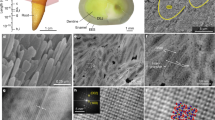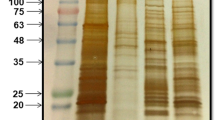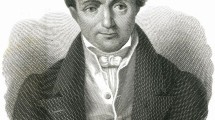Abstract
LITTLE is known about the chemical nature of the organic matrix of enamel, although it presumably plays an essential part in the initiation and organization of the growth of hydroxyapatite crystals. The mature enamel finally resulting from these processes is the hardest and most highly mineralized of vertebrate tissues. Other mineralized tissues, bone1 and dentine2, contain 15–26 per cent of persistent organic matrix, at least 90 per cent of which is collagen. Mature human enamel contains only some 0.6 per cent of organic matter and 0.36 per cent of proteins, approximately half of which are soluble in acid decalcifying fluids3. Investigations of the composition of enamel proteins have been largely confined to insoluble residues from the demineralization of the mature tissue3–5, A recent finding, in this laboratory, that partly mineralized enamel from developing teeth in the human fœtus contains approximately 20 per cent of material of protein character was followed by a preliminary investigation of its amino-acid composition.
This is a preview of subscription content, access via your institution
Access options
Subscribe to this journal
Receive 51 print issues and online access
$199.00 per year
only $3.90 per issue
Buy this article
- Purchase on Springer Link
- Instant access to full article PDF
Prices may be subject to local taxes which are calculated during checkout
Similar content being viewed by others
References
Eastoe, J. E., “The Biochemistry and Physiology of Bone”, edit. by Bourne, G. H. (Academic Press, New York, 1956).
Long, C., “The Biochemist's Handbook” (Spon, London, in the press).
Stack, M. V., J. Amer. Dent. Assoc., 48, 297 (1954).
Hess, W. C., Lee, C. Y., and Neidig, B. A., J. Dent. Res., 32, 585 (1953).
Battistone, G. C., and Burnett, G. W., J. Dent. Res., 35, 260 (1956).
Eastoe, J. E., Biochem. J., 74, 8 P (1960).
Eastoe, J. E., Biochem. J., 61, 589 (1955).
Bowes, J. H., and Elliott, R. G., J. Soc. Leather Tr. Chem., 41, 87 (1957).
Partridge, S. M., and Davis, H. F., Biochem. J., 61, 21 (1955).
Tristram, G. R., “Adv. Protein Chem.”, 5, 83 (1949).
Losee, F. L., and Hess, W. C., J. Dent. Res., 28, 512 (1949).
Fish, E. W., and Harris, L. J., Phil. Trans., B, 223, 489 (1934).
Author information
Authors and Affiliations
Rights and permissions
About this article
Cite this article
EASTOE, J. Organic Matrix of Tooth Enamel. Nature 187, 411–412 (1960). https://doi.org/10.1038/187411b0
Issue Date:
DOI: https://doi.org/10.1038/187411b0
This article is cited by
-
Biomimetic mineralisation systems for in situ enamel restoration inspired by amelogenesis
Journal of Materials Science: Materials in Medicine (2021)
-
A novel nonsense variant in SLC24A4 causing a rare form of amelogenesis imperfecta in a Pakistani family
BMC Medical Genetics (2020)
-
Enamel biomimetics—fiction or future of dentistry
International Journal of Oral Science (2019)
-
Early Pleistocene enamel proteome from Dmanisi resolves Stephanorhinus phylogeny
Nature (2019)
-
Murine matrix metalloproteinase-20 overexpression stimulates cell invasion into the enamel layer via enhanced Wnt signaling
Scientific Reports (2016)
Comments
By submitting a comment you agree to abide by our Terms and Community Guidelines. If you find something abusive or that does not comply with our terms or guidelines please flag it as inappropriate.



